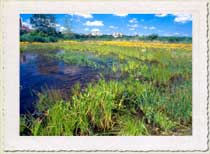
Flushing Meadows-Corona Park
Willow Lake Preserve
Borough: Queens
Acres: 106
Habitat Type: Freshwater Wetland
Map: PDF
Willow and Meadow lakes are, collectively, the largest fresh water bodies in Queens, and among the largest fresh water bodies in the city. Willow Lake has been managed as a natural area since the 1930s and was designated a protected freshwater wetland in 1976. In 1996 members of Boy Scout Troop 530 and students from John Bowne High School reconstructed the nature trail around Willow Lake. The half-mile wood chip trail is an enjoyable ramble through 55 acres of plant life, migratory bird habitats, and wildlife native to New York State.
True to its namesake, the Willow Lake area is home to a wide variety of willows, plants belonging to the Salix genus, including the tall white willow (Salix alba), the weeping willow (Salix babylonica), the shorter goat willow (Salix caprea), and the pussy willow (Salix discolor). Other plants, trees, and flowers one might encounter while on a stroll are the blue flag iris (Iris versicolor), eastern cottonwood (Populus deltoides), staghorn suman (Rhus typhina), phragmites (Phragmites australis), black cherry (Prunus serotina), elderberry (Sambucus canadensis), and white waterlilies (Nymphaea odorata).
Willow Lake is a bird watcher’s paradise. Northern shovelers (Anas clypeata), yellow warblers (Dendroica petechia), black-throated green warblers (Dendroica virens), savannah sparrows (Passerculus sandwichensis), rough-winged swallows (Stelgidopteryx serripennis), yellow-shafted flickers (Colaptes auratu), white-crowned sparrows (Zonotrichia leucophrys), swamp sparrows (Melospiza georgiana), eastern meadowlarks (Sturnella magna), water pipits (Anthus rubescens), marsh wrens (Cistothorus palustris), red-winged blackbirds (Agelaius phoeniceus), great egret (Ardea albus), mallards (Anas platyrhnchos), and ring-necked pheasants (Phasianus colchicus) have all been recorded at Willow Lake. In and around the lake one can also spot the eastern painted turtle (Chrysemys picta), muskrats (Ondatra zibethicus), carp (Cyprinus carpio), and killfish (Fundulus spp.).
Directions
You can access the trail from 72nd Road and Grand Central Parkway and from 73rd Terrace and Park Drive East.
